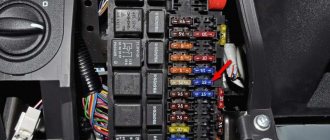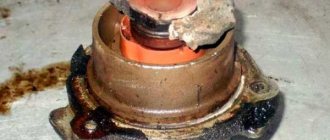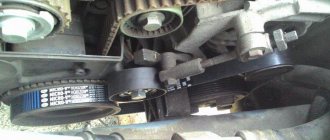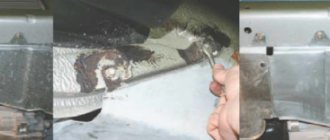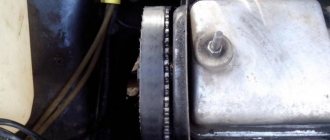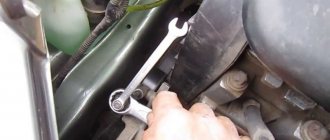Geely MK timing unit requires timely and high-quality care. The maintenance regulations for this vehicle require replacing the timing belt every 60,000 (km) mileage . Along with the belt, the timing pulley .
Replacing the timing belt on a Geely MK car is quite a difficult task. To get to the timing belt, you will have to dismantle the valve cover and the right support of the power unit.
Experts strongly recommend not to skip scheduled timing belt maintenance. Once the belt stretches and sag, it will jump several or more teeth, throwing off the valve timing . The Geely MK drive system can bend valves when the timing belt breaks.
The process of replacing the timing belt on Geely MK
- We turn off the car in the inspection hole.
- Open the hood and disconnect the negative wire from the battery.
- We go down under the car and dismantle the right mudguard . It is secured with 2 bolts to the bumper and 2 bolts to the body side member.
- We remove the right front wheel , after jacking up the right front part of the car. Don't forget to place a safety stop.
- Remove the generator belt . To do this, loosen the generator mounting bolts. Loosen the belt tensioner and remove the alternator belt.
- Remove the air conditioner belt . To do this, loosen the nut on the tension roller. Next, loosen the tensioner and remove the belt.
- Remove the power steering belt . To do this, loosen the lower power steering bolt. Next, loosen the top bolt and remove the belt.
Right support
- We dismantle the right suspension support of the power unit . The engine should be supported.
- Removing the air filter housing.
- We move the air conditioning system pipes to the side , having previously unscrewed the bracket bolt.
- We unscrew the 2 bolts that secure the support to the engine.
- Unscrew the 3 bolts securing the support to the body.
- Unscrew the fastening nut that secures the support to the bracket .
- Removing the support.
Valve lid
- Remove the valve cover . To do this, first disconnect crankcase ventilation hose
- We remove the tips from the spark plug heads and move the high voltage wires .
- Unscrew the valve cover . 4 fixation points.
- We pry up and remove the valve cover to the side.
We continue to disassemble the timing belt
- Set the piston of the first cylinder to the TDC position . To do this, turn the crankshaft pulley until the marks on the crankshaft pulley the number “0”. The marks should also match on the camshaft .
- Remove the upper timing belt protective cover . 4 fixation points.
- Remove the middle protective cover . 2 fixation points.
- Remove the crankshaft pulley . You need to ask your partner to press the brake pedal all the way.
- Removing the lower timing belt guard.
- Remove the crankshaft timing belt washer.
- Loosen the tension roller bolt.
- Remove the timing belt . You should first make sure that the pulleys are in the TDC position of the piston of the first cylinder. That is, you need to check the coincidence of the marks.
- Removing the tension roller.
- We replace worn parts.
- We assemble the timing belt assembly in the reverse order.
This is interesting: VAZ 2114 fuses: where they are, replacement
Preparatory operations
We remove the air filter cover along with the pipe, as well as the high-voltage wires.
Also, unscrew the three bolts and remove the bottom of the filter housing.
Disconnect the negative terminal of the battery, then the connector and terminal from the generator.
Unscrew the eight nuts 10 securing the valve cover.
Valve cover fastenings.
Loosen the generator tensioner mounting nut (green arrow) and unscrew the generator tensioner bolt (red arrow). We move the generator to the side, thereby loosening the generator belt and remove it.
Alternator belt tension.
We remove the engine mount.
Engine mount mounting.
Next, unscrew the tension roller nut and unscrew the tensioner bolt to loosen the air conditioner belt. We remove it together with the video.
Air conditioner tension roller.
Remove the top timing belt cover.
Upper timing cover.
Important! Remove the TPS connector, otherwise you will tear it off when you lift the engine.
We block the crankshaft and unscrew the pulley bolt and remove it. Loosen the lower bolt securing the power steering pump.
Remove the lower timing belt cover.
Loosen the upper power steering bolt and, by moving it, remove the power steering belt.
After unscrewing the four 10mm bolts, remove the pump pulley.
Set top dead center (TDC)
We turn the crankshaft until the hole in the camshaft sprocket, marked with the letter “K,” is against the mark located on the camshaft bearing cover.
Important! Be sure to turn the crankshaft clockwise.
The marks on the crankshaft sprocket must also match.
Crankshaft mark.
Unscrew the bolt securing the tension roller and remove it along with the timing belt.
We take out a freshly purchased timing belt kit.
Timing kit.
Execution Sequence
Replacing the timing belt of Geely MK, MK Cross is carried out after the engine has cooled down, in several stages:
- Disconnect the battery by disconnecting the terminals.
- Remove the wires from the generator that are located above the valve cover to make it easier to remove.
- Remove the air filter box.
- Disconnect the fan tubes from the valve cover and unscrew the nuts (leave the cover itself in place for now so that nothing gets under it).
- Raise the car with a jack, unscrew the wheel and protective covers: first metal, then plastic;
- Remove the alternator belt and loosen it as much as possible to make it easier to access the timing belt covers.
- Remove the air conditioner drive belt and tensioner pulley.
- Remove the valve cover.
- Remove the upper timing belt cover
- To remove the KV pulley, if there is no special key, there is another way; you will need two people: one presses the brake pedal, and the other unscrews the nut at the same time (to the left).
- Remove the lower timing belt cover.
- Loosen the engine support: there are two bolts and a nut at the bottom.
- Raise the engine with a jack (place a block for protection); completely detach the pillow from it.
- Place marks on the belt and pulleys so that a new one can be placed on them (a white metal marker is suitable for marks).
- Remove the old belt, check the tension roller, if everything is fine, install a new one, the Powergrip belt has good characteristics.
- Reassemble everything in reverse order.
When replacing the timing belt, do not turn the crankshaft and camshaft so as not to disturb the valve timing.
First you need to prepare a heat-resistant sealant and a new gasket for the valve cover.
It is better to take the correct tension of the drive belts from the service manual.
It is better to carry out the work with an assistant.
To complete the replacement and complete assembly, start the engine and check that all systems are working properly. This completes the process of replacing the Geeley MK timing belt with your own hands. It takes 2-3 hours, but you can save a decent amount and gain valuable experience in car repair.
In what cases is replacement necessary?
The timing belt is designed to synchronize the shafts: camshaft and crankshaft. Thus, the crankshaft and camshaft speeds are the same. The valves open and close synchronously with the movement of the pistons. In addition, the timing belt drives the oil and air pump. Therefore, it experiences heavy loads and requires constant monitoring of its condition.
The reliability of this component is very important for the operation of the motor. The pistons and valves are in the same space, but thanks to the timing belt they never meet. When the belt breaks, the valves begin to hit the pistons. As a result, both become unusable, which leads to expensive engine repairs. The period for replacing the Geely MK timing belt is indicated in the car’s operating manual and is 60 thousand kilometers.
The frequency of replacement depends not only on the period specified in the instructions, but also on:
- operating conditions;
- quality of consumables;
- correct installation of components.
The effective operation of the gas distribution mechanism largely depends on the degree of tension of the timing belt. If the tension is too strong, the drive and crankshaft bearings, as well as the gear surface, quickly wear out. If the tension is insufficient, then the necessary synchronization is not ensured: the engine loses power and the car does not start well.
Regardless of the planned replacement, a control inspection of the timing parts should be done every 20 thousand kilometers. The belt must be changed if the following defects are detected:
- cracks, assemblies, wear of the external surface;
- tearing and wear of teeth;
- mechanical damage to the toothed surface;
Old consumable with worn surface - traces of oil on any surface;
- fraying of the sidewalls;
- tissue separation.
If there are traces of oil on the belt, it is better to replace the product immediately, without waiting for it to break, as it quickly destroys the rubber, shortening the service life of the belt. When replacing, you should always ensure that consumables are installed correctly, as any distortions will shorten the service life of the products. In the video you can see how to install the strap correctly. In addition, when changing the belt, it is necessary to change the tension roller. If, during inspection of the pump, defects are identified or play is observed, then it also needs to be replaced. Traces of oil indicate that the crankshaft and camshaft seals need to be replaced.
Additional Information
The official service manual for Geely MK recommends performing scheduled inspections of the timing belt every 20,000 - 30,000 (km) mileage . Attention should be paid to: the tightness of the pump , the integrity of the tension roller, as well as the tension and technical condition of the belt. An oiled timing belt should be replaced as soon as possible, without waiting for scheduled maintenance, since oil corrodes the rubber .
Oil may leak through camshaft and crankshaft seals If there are traces of oil on the timing belt, then in this case the leaking seals should be replaced.
Regarding oil seal leakage, this problem needs to be solved comprehensively. Simply replacing worn out oil seals with new ones will only temporarily eliminate the problem. The engine will eat oil until the pressure under the valve cover, that is, inside the engine, stabilizes. The pressure in the engine increases due to improper operation of the exhaust system. Most often, increased pressure is the result of a clogged catalyst.
It is worth noting that after servicing the timing belt, the valve cover gasket . In addition to the mileage of 60,000 (km), the service life of the water pump of the engine cooling system ends. As a rule, the pump is replaced along with the timing belt.
Maintenance of the timing belt assembly should be carried out with 4 hands, that is, together with a partner.
Replacing the timing belt Geely MK
Geely Kingkong 2005 - present
Hello! Are there any step-by-step instructions or tips on where to start replacing the timing belt on a Geely Kingkong?
In principle, you can easily change the timing belt on a Geely MK with your own hands; there aren’t a lot of instructions on the Internet, but the principle itself is not complicated. I can write a small explanation:
- First of all, remove the ground terminal from the battery.
- Disconnect the wires from the generator so that they do not interfere with removing the valve cover (secured with nuts and a latch).
- Then you also need to remove the engine air filter housing.
- Also disconnect the 2 hoses and unscrew the 4 bolts of the valve cover (it’s better not to remove it right away so that dirt doesn’t get in).
- Jack up the car on the right side and remove the wheel, fender liner and lower plastic protection.
- Now you need to remove the hanging belts (alternator belt and others; to do this, you need to loosen the drive belt as much as possible, so that it is easier to get to the timing belt covers.
- Then remove the air conditioning belt and tension pulley. How to do this is described more clearly and in detail on the monolith page here; by the way, there is also a description of the procedure for replacing the timing belt with all the details such as tightening torques and the sequence of work.
- Remove the valve cover.
- Remove the upper timing belt protection.
- And now you need to remove the KV pulley, having a pulley will be easier, but if you don’t have one at hand, then we call a friend and do this: one presses the brake, and the other unscrews the nut (by the way, it has a right-hand thread). And although the pulley may rest against the fender liner, there is no need to worry; you can get it out after disconnecting the engine mount.
- Remove the lower plastic timing belt protection.
- Loosen the fastening of the engine mount (2 bolts and a nut at the bottom).
- Now it’s time to jack up the internal combustion engine (using a wooden block) and disconnect the mount from the engine.
- Having the opportunity to look and see all the timing marks (you need to set them exactly according to the marks and there are a lot of them, in a variety of places), but you don’t have to overthink anything, but simply put your marks on the belt and pulleys, then put a new one in the same way.
- And so we remove the timing belt from our Geely, check the condition of the tension roller, install a new belt, check the tension.
- Let's put everything back together in reverse order.
There is useful information on the tags in the video (although it is of poor quality, I think you can figure it out). And so, if you don’t have a manual for your car model, look on the Internet for a Toyota with the same engine, since the engines on the Geely are Toyota ones.
- Geely King Kong engine overheating - 5 answers
- Geely Kingkong shock absorber nut won't come off - 1 answer
- How to remove the outer handle of the right rear door of Geely MK? – 1 answer
- Do the valves bend when the timing belt breaks on the MR479QA engine in Gili Qingkong? – 2 answers
- Changing the oil in a Geely manual transmission - 1 answer
- How to remove a front brake cylinder - 4 answers
Subscribe
to our channel in
Index.Zen
Even more useful tips in a convenient format
Geely MK 2013, engine Gasoline 1.5 liter., 94 hp, Front drive, Manual — scheduled maintenance
Comments 14
1.5 is not enough, they ask us for work 5 and don’t come closer.
I also picked up the timing belt from Emex today. But I won’t change it yet, I still have the factory one, 135 thousand has already run.
The valve does not bend, of course, if the belt breaks, but according to the law of meanness, it breaks at the most inopportune moment. After 100k km, it’s better to update it and not play around with it.
who said that after 100 you need to change? At the factory, who did they put a yellow sticker with the inscription about replacing the belt after 120 thousand? The factory gives a guarantee of 120 thousand for the belt, so 120 is not the maximum service life, but with a reserve. So why pay more?! Yes, 95% of jilivods change in Ukraine for 60 thousand, in Russia I don’t know, but I think + - the same amount and all because they make money from the services. I can give examples when friends changed the factory belt and it broke after 50 thousand, because it was shitty, although it was from a brand name manufacturer and not cheap. Then they just took it and installed the factory one. It was after listening to them and seeing the sad experience that I did not change it, as they say in the services. I believed the factory sticker. Now it’s clear, it’s time, I bought it for sale, it’s lying there, waiting in the wings. Buy a couple more belts and a roller and go into battle).
I just read it and understand that I’m not driving a Geely, but a million-dollar Toyota) From my own experience, I’m convinced that the original is a pig in a poke, and if you install the right analogues, it goes an order of magnitude better.
Well, of course it’s a Toyota, I have a belt from a Toyota and there are stub drains from it and little things, don’t even think that it’s a Dzhilik, this is a Toyota, we’re not rogues, we’re cool, ahaha))) But seriously, I’m like I would like to share my experience, I actually got 135 thousand on the factory belt, I didn’t even bother until 120 thousand, after adjusting the valve, then I changed the gasket and at the same time monitored the condition of the belt. I notice that the MK until 2012 was, as you say, a pig in a poke, but the 2012 restyling is already a good and reliable car. I read an article a long time ago about how the Chinese fixed the bugs and indeed, everything works, unlike earlier versions.
I agree with you kol4in 123 100%, I just started to grunt in the box when it’s cold, but at 80t.km everything else is normal. I don’t count small things like light bulbs and consumable oil and filters.
I just read it and understand that I’m not driving a Geely, but a million-dollar Toyota) From my own experience, I’m convinced that the original is a pig in a poke, and if you install the right analogues, it goes an order of magnitude better.
Why, you need to swap it for a Toyota milliliter, but 3 liters and you’ll get a beast)))
It was changed 20-40 thousand ago, judging by the condition.
About the engine
Car enthusiasts in many countries around the world are well aware of such a car as the Toyota Corolla A100; it was its power unit that was taken as the basis for the Geely MK. Manufacturers from China bought a license for the Toyota 5A-FE engine. It is characterized as a reliable, economical power unit, which, with proper, timely, high-quality maintenance, allows you to drive a million kilometers.
Subsequently, an engine of its own design was developed for the Geely MK MR479FQA. It is rightfully considered one of the best developments by Geely. The technical characteristics of this power unit are in no way inferior to the developments of other well-known engine manufacturers. Experts note its relatively low production cost, low noise level, and good maintainability.
The engine is an in-line design with four cylinders, two overhead camshafts. The valve mechanism requires periodic adjustment, which cannot be ignored. The head is made of aluminum alloy, the inlet and outlet channels are in opposite directions. The timing mechanism is driven by a belt drive, in which the belt requires replacement after some mileage.
Features of the gas distribution mechanism
A special feature of the gas distribution mechanism of this car is the presence of 16 valves, that is, 4 valves per cylinder. To put them into operation, two camshafts are installed in the head, which are driven into rotation by a toothed belt.
The camshafts are equipped with gears that are rotated by a belt. There are also tension and deflection rollers. The Geely timing belt also rotates the coolant pump.
The power unit is designed in such a way that it is difficult to reach the components of the gas distribution mechanism. When the timing belt breaks, the valves on this engine most often do not bend.
see also
Comments 20
What kind of ridiculous prices are these? I bought the same timing belt for 800 rubles. they screw it up scary)
Is this the first time replacing the timing belt on a car?
Tell me, how long did the factory ones last? Officials recommend changing it after 3 years. My fifth one went with a mileage of 45 thousand.
50-55 thousand can be changed, better sooner than later
Tell me, how long did the factory ones last? Officials recommend changing it after 3 years. My fifth one went with a mileage of 45 thousand.
Hello, it’s better to change every 40 tkm The story of my experience I bought a car, the mileage is 101 tkm, everything was ok, on the highway the traction dropped sharply and the car seemed to be suffocating. As a result, the timing belt jumped due to the fact that the plastic protection of the timing belt crumbled... just like that A According to the regulations, every 60 tkm, that is, I planned to change it at 120 tkm, but it didn’t work out...
Well, as far as I understand, the timing belt protection for the car is disposable and should also be in stock when replacing belts. I still have the factory belt, and as you know, the factory one (even if it’s from China) is better. Yes, and from personal experience. Where the rubber in the suspension was changed, after half a year it became covered with cracks. This is why I want to delay the moment of replacing the original belts. Although there are already drive belts in the car, because at temperatures below 15 degrees there is a whistle when warming up for less than a minute with normal tension and appearance. I have not yet decided on the choice of brand of timing belt manufacturer. Judging by the information on the website, the factory one will easily withstand a mileage of 50-80 t.km, but the replacement ones are already enough for 30-40. What brand of timing belt did you have?
Yes, the belt, in principle, will not break, but the drawback, yes, is in the plastic casing and perhaps partly in the roller) So don’t delay it, at least change the protection) it seems to be sold already together with the belt and roller, but it should also be available separately
Author. Are the spark plug well seals easy to change?)))
I think so, the master didn’t talk about difficulties.
For some reason I thought that on the MK, just like on my M4, there was a chain...
On MK belt. And happiness for the owners. Does not bend the valve if it breaks.
The fact that the valve does not bend has nothing to do with the presence of a belt. The Hover H2 has a belt, but the valves bend if you're unlucky.
I didn’t connect this together)) just information))
This is what the answer looked like)
For some reason I thought that on the MK, just like on my M4, there was a chain...
On the emgrande chain
How does this relate to the subject of the conversation?
Just suggested which class does Geely have a timing chain drive, is there something you don’t like?
Replacement procedure
Carrying out the operation is not particularly difficult; it is quite possible for owners who confidently hold wrenches in their hands and know the structure of their car. It is best to work on a lift or inspection pit. If this is not possible, the replacement can be done on level ground, but you will need a car jack.
The manufacturer recommends purchasing original spare parts for replacement. Namely:
- Geely E030000701 Timing belt;
- Geely E030200005 Timing belt tensioner.
In addition to the consumables that will be changed, you will need a set of wrenches, oil-resistant sealant, and rags. If you plan to replace the coolant pump, have antifreeze ready to top it up. It is advisable to have an assistant nearby, since you will not be able to perform certain operations yourself.
Worn consumables need to be replaced only on a cold engine.
The process will occur approximately in this order:
- The machine is installed at the work site. If it is a flat area or an inspection hole, it is necessary to place wheel chocks under the rear wheels. After this, open the engine compartment hood and disconnect the battery terminals.
- Next, disconnect the high-voltage wires from the spark plugs. To remove the valve mechanism cover, use a “10” key to unscrew the four nuts, remove them together with the washers, and dismantle the valve mechanism cover.
- Three plastic protective covers prevent you from removing a worn belt; after removing the fastening bolts, they are removed from the engine compartment.
Top protective cover
Middle protective cover
Bottom protective cover
- Now, for ease of operation, disconnect the wires from the generator set, loosen the upper bolt of its fastening, and remove the generator belt.
- Next, release the tension roller of the car air conditioning compressor drive and the screw securing the power steering pump. This work is best done from underneath the machine.
- The next step is to install the timing mechanism according to the marks.
Crankshaft mark
- Now it's time to remove the power unit support in order to lift the engine with a jack. You need to place a wooden stand under the crankcase.
- Having removed the engine mount, it is lowered all the way into the spar. This is necessary to access the crankshaft pulley.
- To remove the crankshaft pulley, stop the engine from turning in an accessible way and unscrew the pulley mounting bolt.
Fixing the crankshaft pulley
Removing the crankshaft pulley
- Unscrew the screw securing the tensioner, disconnect the spring from it and remove the roller. After this, you can remove the belt; first you need to raise the engine a little with a jack.
- Assembly is carried out in reverse order. They start with the belt tension mechanism. Put a spring on the roller and install it in its place. The protrusion on the roller body should be aligned with the groove on the cylinder block, otherwise it will be impossible to tension the belt.
- The new belt is installed on the camshaft pulley in such a way that the inscription on it can be read; if it has an arrow, it should be directed clockwise.
- The belt is tensioned with a roller; it should be turned in the direction of the arrow on the body. After installing all the parts in their place, you should once again make sure that all the installation marks match, and turn the crankshaft two turns. If after this all the marks match, the work can be considered successfully completed.
Alignment marks
The efficient operation of the power unit is ensured by the correct selection of valve timing. To set them, manufacturers apply several installation marks to the timing drive parts. On the inside of the camshaft support there is a mark “E1” which should coincide with the mark “K” on the camshaft pulley; it is marked in a circle. In this case, there are two marks on the pulley, which should be in a horizontal position strictly on the cut of the cylinder head housing.
E1 and K marks
There are also installation marks on the crankshaft pulley and the protective cover of the timing mechanism. The pulley key should be at the top, the pulley cutout coincides with the end of the protrusion of the timing drive protective cover. The crankshaft pulley also has a groove that matches the mark on the cylinder block.
Equipment and Tools Required for Belt Replacement
To change the timing belt with your own hands, you need to have an inspection hole, use a lift or elevation. If there is no lift, then at home you can use a jack to lift the car, which any motorist must have. If such a replacement has not been carried out independently before, it would be a good idea to arm yourself with a manual or look in advance on the Internet to see how the replacement procedure occurs.
To make equipment repairs faster, it is best to collect all the necessary tools in advance, which include:
- Wrenches of different sizes.
- Various heads with long handles.
- Equipment designed to control the tightening force of parts.
- Gear removal device.
- Screwdrivers are shaped like a tip.
- Insulation.
- Felt pen.
- Clean cloth.
- Other small consumables.
For the replacement to be successful, it is recommended to carry out the repair with an assistant. Better, this person has an idea of how to make repairs and replaced the belt himself.

